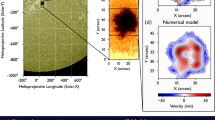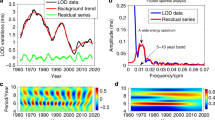Abstract
Measurements of the frequencies of various modes of trapped acoustic waves provide information about rotation and structure within the Sun. Previous work dealt with observations of wave modes confined near the solar equator, which provided some information about the depth variation of rotation without resolving a possible latitude variation1,2. Recent work extended measurements to modes covering various latitude ranges from which the variation with latitude of solar rotation can be studied3–5. Since these measurements were restricted to modes with spherical harmonic degrees less than 50, they provide averages of rotation over great depth ranges that do not resolve the convective envelope. We now present new results for degrees up to 98 which allow the convective envelope to be isolated. For degrees between 20 and 98 we find no evidence that internal rotation differs significantly with depth or latitude from the rotation of surface magnetic field patterns. Modes covering a wide latitude range have systematically lower frequencies than those confined near the equator, indicating the existence of a structural asymmetry within the Sun.
This is a preview of subscription content, access via your institution
Access options
Subscribe to this journal
Receive 51 print issues and online access
$199.00 per year
only $3.90 per issue
Buy this article
- Purchase on Springer Link
- Instant access to full article PDF
Prices may be subject to local taxes which are calculated during checkout
Similar content being viewed by others
References
Duvall, T. L. Jr & Harvey, J. W. Nature 310, 19–22 (1984).
Duvall, T. L. Jr et al. Nature 310, 22–25 (1984).
Brown, T. M. Nature 317, 591–594 (1985).
Brown, T. M. in Seismology of the Sun and the Distant Stars (ed. Gough, D. O.) 199–214 (Reidel, Dordrecht, 1986).
Libbrecht, K. G. Nature 319, 753–755 (1986).
Snodgrass, H. B. Astrophys. J. 270, 288–299 (1983).
Snodgrass, H. B. Solar Phys. 94, 13–31 (1985).
Harvey, J., Pomerantz, M. & Duvall, T. Jr Sky Telesc. 64, 520–523 (1982).
Pomerantz, M. A. Harvey, J. W. & Duvall, T. Jr Antarctic J.U.S. 17(5), 232–233 (1982).
Jensen, E. & Orrall, F. Q. Astrophys. J. 138, 252–270 (1963).
Duvall, T., Livingston, W. & Mahaffey, C. in Nonradial and Nonlinear Stellar Pulsation (eds Hill, H. A. & Dziembowski, W. A.) 237–240 (Springer, Berlin, 1980).
Harvey, J. in Future Missions in Solar Heliospheric & Space Plasma Physics (eds Rolfe, E. & Battrick, B.) 199–208 (ESA, Noordwijk, 1985).
Gough, D. O. & Taylor, P. P. Mem. Soc. Astron. Ital. 55, 215–226 (1984).
Author information
Authors and Affiliations
Rights and permissions
About this article
Cite this article
Duvall, T., Harvey, J. & Pomerantz, M. Latitude and depth variation of solar rotation. Nature 321, 500–501 (1986). https://doi.org/10.1038/321500a0
Received:
Accepted:
Issue Date:
DOI: https://doi.org/10.1038/321500a0
Comments
By submitting a comment you agree to abide by our Terms and Community Guidelines. If you find something abusive or that does not comply with our terms or guidelines please flag it as inappropriate.



